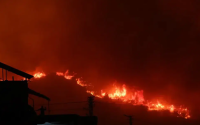 Experts are certain Oetzi died from an arrow that pierced his shoulder |
6 June 2007
Oetzi probably died as the result of a fight: he may either have fled his attacker - who then shot him in the back - or been ambushed.
The remains of the Neolithic man were discovered in 1991 emerging from a melting glacier.
They have since been subjected to a long series of investigations, with the latest results being published in the Journal of Archaeological Science.
Examination of food - and perhaps more importantly - tree pollen in his stomach has established that Oetzi started his day with a meal in a wooded valley below the Alps.
But later the same day, he was involved in a fight. This assessment is based on the presence of a flint arrowhead lodged in his back and extensive cuts to his hands.
No one can be sure whether this attack took place in the valley below, prompting Oetzi to flee up the mountain; or whether he was involved in a violent scrap at the 3,210m (10,500ft) altitude where his body was discovered on the border between Austria and Italy 16 years ago.
Cold case
Recent advances in computerised tomography (CT), a sophisticated X-ray scan that allows multidimensional imaging, have given researchers an unprecedented view of Oetzi's internal anatomy.
The pictures reveal a 13mm-long rip in Oetzi's left subclavian artery which lies just under the collar bone.
Blood poured out into the surrounding tissue, forming a haematoma that can be seen in the breast cavity.
"We can conclude that this was really a deadly hit from the arrowhead," Dr Ruhli told the BBC News website. "He would not have walked around for days. It was a quick death.
"Theoretically, you could have been hit by an arrow and survive. If it doesn't hit an artery or the lung, and you don't get an infection it shouldn't be a problem."
Clotted blood also entered the hole caused by the arrow's wooden shaft, showing that it was broken off while Oetzi was still alive and therefore still bleeding.
Oetzi climbed up to the Schnalstal Glacier and died from cardiac arrest, brought on by shock, after sustaining massive blood loss, the science team says.
Cover up?
Dr Ruhli speculated that it was possible the Iceman removed the shaft himself.
Alternatively, it could have been removed by an ally who tried in vain to help him, or perhaps by the attacker - if his arrows had a characteristic shaft - to try to cover up evidence linking him to the killing.
 Scientists have modelled the arrowhead embedded in his back |
But Dr Ruhli added, "this is speculation, because someone might have helped him up there. I'd rather stick to the facts".
It is impossible to tell whether Oetzi was hit while he was walking, running, or stationary. But it seems the arrow was shot from below Oetzi, suggesting the killer was either kneeling or further down a hill.
The arrow hit with some considerable power, penetrating the Iceman's shoulder blade.
Oetzi represents one of the great archaeological finds of recent years. He takes his name from the Oetz Valley where he was found - still wearing goatskin leggings and a grass cape.
His copper-headed axe and a quiver full of arrows were lying nearby.
At first, it was thought he died from cold and hunger, but researchers were eventually able to establish that he died from injuries sustained in a conflict.
Oetzi was about 159cm tall (5ft, 2.5in), 46 years old, arthritic, and infested with whipworm.






